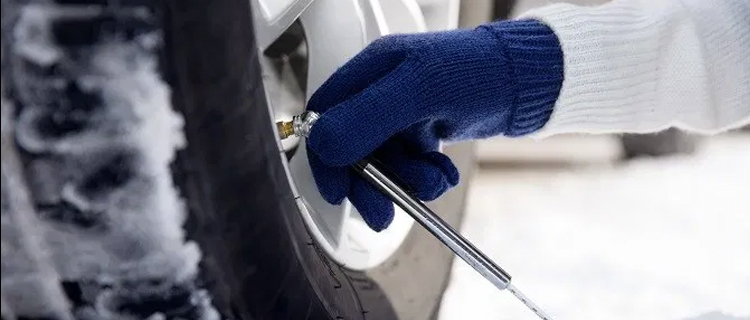Managing Tire Pressure in Cold Weather: What You Need to Know Come Winter
October 19, 2020
Maintenance

Today’s post is all about managing tire pressure in cold weather. Read on to learn common causes for deflation, the risks of driving on underinflated tires, and how to manage this common winter driving concern.
Why Do I Lose Tire Pressure in Cold Weather?
When most drivers think about managing tire pressure, leaks and punctures come to mind. But there’s another culprit hiding in plain sight: cold weather!
In fact, tire pressure can decrease about 1 PSI (pound per square inch) for every 10 degrees the temperature drops. But the air isn’t escaping or leaking out of your tires; it’s just contracting, as the cold drives the molecules closer together. This reduction in volume causes tire pressure loss, and before you know it, your tires are underinflated. It’s similar to how a cake comes straight out of the oven all puffed up, then flattens out as it cools.
Because we lose tire pressure in cold weather, it’s quite common to see the low-pressure indicator light on first thing in the morning, since the temperature dropped overnight. In these instances, the light may shut off on its own after driving for 20 minutes or so, as the air warms up and expands.
Safety Concerns Regarding Low Tire Pressure in Cold Weather
Underinflated tires pose serious safety concerns, especially during the winter months where driving conditions are already less than ideal.
- Underinflated tires are one of the leading causes of tire failure. When tire pressure is insufficient, the tire spreads out under the weight of the vehicle, and too much rubber meets the road. This greatly increases the amount of friction, which can cause overheating, premature wear, tread separation, and blowouts.
- Underinflated tires can affect steering and handling. When tires lose pressure in cold weather, the sidewalls flex more than they’re supposed to during cornering and braking. This causes the tread to squirm, which results in much less stability and traction.
The Cost of Low Tire Pressure in Cold Weather
In addition to the safety concerns mentioned above, underinflated tires cost you money. Increased tire surface contact causes more rolling resistance and friction, which leads to poor gas mileage and higher fuel costs, to say nothing of the extra wear it puts on your tires!
What Can I Do To Manage Tire Pressure in Cold Weather?
You might not be able to control the weather, but there’s plenty you can do to keep your tires in shape this winter.
Most vehicles come with a Tire Pressure Monitoring System (TPMS), but this shouldn’t be the only thing you rely on. That’s because the TPMS light only comes on when your tires are at least 25% below the proper air pressure.
Instead, we recommend regularly checking your tire pressure in cold weather and topping them off as needed. Once per month is a great place to start.
The process is simple:
- Remove the cap from the tire valve
- Make sure the gauge’s measurement stick is completely inside the tire gauge
- Place the open end of the gauge firmly over the tire valve stem
- As soon as the measurement stick extends out, consult the PSI reading on the far right of the stick
- Repeat this process 2-3 times to ensure accuracy, then repeat on every tire
If you notice any underinflation, you can fill your tires at most gas stations, using a commercial inflator, or visiting your local TIRECRAFT specialists.
Managing Tire Pressure in Cold Weather with TIRECRAFT
If you’d rather leave your tire pressure woes to the pros, use our Find a TIRECRAFT tool to locate a nearby specialist. We offer free tire pressure checks and some of the best service in the country!
Back

